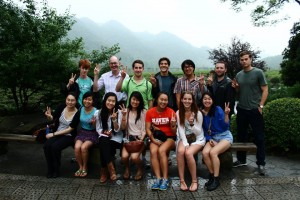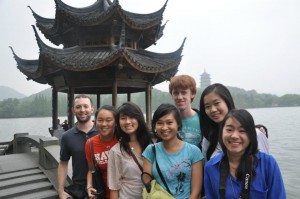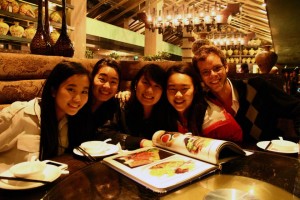By Cynthia Yang and Thomas Armstrong
May 25th
Wednesday morning we left the “city above the sea” for the provincial capital of Suzhou. About 50km outside of Shanghai, rows of fields replaced the endless expanse of skyscrapers. But about two hours later, we were back to the familiar landscape of high-rise apartments buildings. We stopped in a government-reconstructed village in older Suzhou to grab lunch. After passing all the American franchises like KFC and McDonalds, we walked into some of the side streets to check out the local food. None of the street food looked appetizing so we went to a local favorite. Ordering was a bit of a struggle because customers are supposed to write down their orders on a slip of paper and then pay for those dishes, but none of us knew enough Chinese to read the menu by ourselves or write down anything. The waiter laughed at our foreignness but then kindly helped us out by taking our order. We ordered traditional beef noodles and dumplings called shu mai, which were both delicious.
While Cynthia and most of the group split off, I went to a local restaurant with Luman and Professor Sheehan. Luman was heart-set on ordering her favorite Suzhou dish: watermelon chicken soup. Naturally, the kitchen wasn’t serving that dish. But Luman still ordered a delicious meal of sweet lotus root, roast chicken, wonton soup, and other tasty snacks. After lunch, the three of us explored the less touristy neighborhoods, conversing with locals and stumbling upon a several hundred year old well still in use. We met up with the group and headed off to one of Suzhou’s most famous garden (the Humble Administrator’s Garden), and the provincial art museum designed by I.M. Pei.
The garden was scattered with pavilions, each displaying a different room from a specific era. My favorite was the “House of Sweet Smelling Rice” that showed a traditional dining area. Our tour guide David told us that one of the bridges we walked over was designed to be crooked because, according to Chinese legend, the devil could only walk straight. The pathways of the garden were also designed with Chinese symbols of luck, such as the bat. According to David, the “Humble Administrator” had ironically designed part of his pathways to be in a stacked arrow formation resembling the Chinese character for people, “ren,” because he wanted to literally step on the people and show his elite status.
At the art museum, we looked at porcelain pieces, jade sculptures, and snuff bottles that corresponded with our study of the porcelain industry and opium trade in China. One of the jade pieces was meticulously carved out of an elephant tusk, with dozens of figures created out of the huge piece of ivory. This served as a reminder of China’s influence and connectivity with the world, even hundreds of years ago. Post-museum, we checked into the hotel and ate a traditional Chinese dinner at the hotel restaurant. The night included a fine performance of “Hey Jude” from Logan “Justin Timberlake” Heley, a pool game against an American history professor teaching in Suzhou, and exploring the Suzhou nightlife.
May 26th
We woke up and boarded the bus to SeAll, a logistics factory at the heart of the Suzhou Industrial Park. The complex—built only 18 years ago—houses over a million people. Located on “Modernization Road,” the factory serves as a center for goods assembly and trade, handling nearly $100 billion in goods this past year. We then drove back to downtown Suzhou where we toured a silk factory. Our tour guide was a very energetic woman who explained to us the life cycle of a silk worm. In case you are wondering, after the silk worm spins a cocoon, “the farmer, they kill them” (a quote from our tour guide). The factory showed every process of manufacturing the silk from examining the quality of the cocoons by hand to unraveling the cocoons and stretching them out to make silk products.
After the silk factory, we left for Hangzhou. Three hours later, we arrived at the Sophia Hotel. Each room number began with 8—a sign of luck in Chinese culture. We went out for a planned group dinner on Luman’s birthday. She split off and had a second birthday dinner of a favorite Hangzhou specialty, sweet and sour fish from the famous West Lake. Later that night, some of us went to a popular club G+ and mingled with locals. We met a fellow Southern Californian from Long Beach named P.I., who was breaking into the entertainment industry in China.
May 27th
Friday may have had the best food of the trip to date. In the morning we toured a picturesque tea plantation outside of Hangzhou, where we learned the history and production of tea. Included in the tour was a tea tasting session, where we sampled four different flavors of fresh tea. We left the boutique shop and made sure to snap some group photos before returning to the cityscape. After a visit to another silk museum, we ate a group lunch at a restaurant on shores of “Xihu” (West Lake). After lunch, the group split up. David and Luman went on a bike tour around Xihu, some returned to the hotel, and others, toured the lake. Cynthia and I were among the people who walked around the lake, admiring the pagoda and a pool with a mass of turtles. Eventually we all returned to our hotel rooms to rest before going out for dinner and more exploration.
When we headed out again, we were in search of delicious street food and shopping. One local favorite was a sticky rice treat with a thin rice peel. The shops and vendors all sold similar items. Many of the small shops were even selling live animals, including frogs, turtles, eels, and other chickens. Somehow, after an hour or so, we managed to walk in a giant circle and ended back at our hotel. A big group of us took a taxi to bustling downtown Hangzhou to eat at the famous Grandma’s Kitchen. We sat in a booth and ordered several dishes to share including kung pao pork, eggplant, pot stickers, lamb chops, and fried rice. Needless to say, no one left hungry. The bill came out to everyone paying 35RMB so about $5USD. A steal. After dinner, we walked around the nearby shopping mall and saw many of the latest fashion trends. After cabbing it back to the hotel, a big group went back to G+ where they saw P.I. perform and met more locals.






